HSFAN: A Dual-Branch Hybrid-Scale Feature Aggregation Network for Remote Sensing Image Super-Resolution
Abstract
1. Introduction
- We design a dual-branch feature extraction architecture: the main branch employs hybrid structural blocks to focus on local feature extraction, enhancing the recovery of high-information-entropy regions; the auxiliary branch combines multi-scale depthwise separable convolutions with dual attention mechanisms, effectively reducing computational complexity and strengthening global context modeling.
- We propose a Multi-Scale Parallel Convolution Module (MSPLCK). By using multiple group convolutions of different scales in parallel, it establishes a cross-scale information complementary mechanism, effectively capturing both large areas and fine textures in remote sensing images, and significantly enhancing the network’s capability to capture multi-scale features.
- We propose an Enhanced Parallel Attention (EPA) module that integrates multiple attention mechanisms in parallel to refine and filter feature streams, while extracting both globally shared information and position-dependent local cues, thereby enabling targeted enhancement and reconstruction of edge textures and high-frequency details in remote sensing images.
- We propose a Multi-Scale Large-Kernel Attention (MSLA) module that employs parallel depthwise separable convolutions to capture multi-level details while reducing computational overhead; it further integrates channel and spatial attention to strengthen salient features, thereby improving the model’s sensitivity to parcel boundaries in remote sensing images.
2. Related Works
2.1. Natural Image Super-Resolution Reconstruction Algorithm
2.2. Remote Sensing Image Super-Resolution Reconstruction Algorithm
3. Proposed Method
3.1. Overall Model Structure
3.2. Multi-Scale Parallel Large Convolution Kernel Module
3.3. Enhanced Parallel Attention
3.4. Multi-Scale Large-Kernel Attention
3.5. Loss Function
4. Experiments and Analysis
4.1. Datasets
4.2. Experimental Parameters
4.3. Evaluation Metrics
4.4. Comparative Experiments
4.4.1. Objective Evaluation Index Comparison
4.4.2. Subjective Comparison
4.4.3. Model Complexity Analysis
4.5. Ablation Experiments
4.5.1. Effectiveness Ablation Analysis of Each Component
4.5.2. Effectiveness Analysis of the MSPLCK Module
4.5.3. Effectiveness Analysis of the EPA Module
4.5.4. Effectiveness Analysis of the MSLA Module
5. Conclusions
Author Contributions
Funding
Data Availability Statement
Acknowledgments
Conflicts of Interest
References
- Zhang, C.; Lam, K.-M.; Liu, T.; Chan, Y.-L.; Wang, Q. Structured Adversarial Self-Supervised Learning for Robust Object Detection in Remote Sensing Images. IEEE Trans. Geosci. Remote Sens. 2024, 62, 1–20. [Google Scholar] [CrossRef]
- Lv, Z.; Liu, T.; Benediktsson, J.A.; Falco, N. Land Cover Change Detection Techniques: Very-high-resolution optical images: A review. IEEE Geosci. Remote Sens. Mag. 2022, 10, 44–63. [Google Scholar] [CrossRef]
- Firat, H.; Asker, M.E.; Bayindir, M.İ.; Hanbay, D. 3D residual spatial–spectral convolution network for hyperspectral remote sensing image classification. Neural Comput. Appl. 2022, 35, 4479–4497. [Google Scholar] [CrossRef]
- Yu, W.; Cheng, G.; Wang, M.; Yao, Y.; Xie, X.; Yao, X.; Han, J. MAR20: A benchmark for military aircraft recognition in remote sensing images. Natl. Remote Sens. Bull. 2023, 27, 2688–2696. [Google Scholar] [CrossRef]
- Sitaula, C.; Kc, S.; Aryal, J. Enhanced multi-level features for very high resolution remote sensing scene classification. Neural Comput. Appl. 2024, 36, 7071–7083. [Google Scholar] [CrossRef]
- Yu, X.; Pan, J.; Wang, M.; Xu, J. A curvature-driven cloud removal method for remote sensing images. Geo Spat. Inf. Sci. 2023, 27, 1326–1347. [Google Scholar] [CrossRef]
- Wen, W.; Zhao, Q.; Shao, X. MambaOSR: Leveraging Spatial-Frequency Mamba for Distortion-Guided Omnidirectional Image Super-Resolution. Entropy 2025, 27, 446. [Google Scholar] [CrossRef]
- Wang, M.; Li, Z.; Liu, H.; Chen, Z.; Cai, K. SP-IGAN: An Improved GAN Framework for Effective Utilization of Semantic Priors in Real-World Image Super-Resolution. Entropy 2025, 27, 414. [Google Scholar] [CrossRef]
- James, D.; Sebastian, T. An Application of Markov Random Fields to Range Sensing. In Proceedings of the 18th International Conference on Neural Information Processing Systems, Vancouver British, CA, Canada, 1 December 2004; pp. 291–298. [Google Scholar]
- Kopf, J.; Cohen, M.F.; Lischinski, D.; Uyttendaele, M. Joint bilateral upsampling. ACM Trans. Graph. 2007, 26, 96-es. [Google Scholar] [CrossRef]
- Yang, W.; Zhang, X.; Tian, Y.; Wang, W.; Xue, J.-H.; Liao, Q. Deep Learning for Single Image Super-Resolution: A Brief Review. IEEE Trans. Multimed. 2019, 21, 3106–3121. [Google Scholar] [CrossRef]
- Dong, C.; Loy, C.; He, K.; Tang, X. Learning a deep convolutional network for image super-resolution. In Computer Vision–ECCV 2014: 13th European Conference, Zurich, Switzerland, Proceedings, Part IV 13; Springer: Berlin/Heidelberg, Germany, 2014; pp. 184–199. [Google Scholar]
- Kim, J.; Lee, J.K.; Lee, K.M. Accurate Image Super-Resolution Using Very Deep Convolutional Networks. In Proceedings of the 2016 IEEE Conference on Computer Vision and Pattern Recognition (CVPR), Las Vegas, NV, USA, 27–30 June 2016; pp. 1646–1654. [Google Scholar]
- Lim, B.; Son, S.; Kim, H.; Nah, S.; Lee, K.M. Enhanced Deep Residual Networks for Single Image Super-Resolution. In Proceedings of the IEEE Conference on Computer Vision and Pattern Recognition Workshops (CVPRW), Honolulu, HI, USA, 21–26 July 2017; pp. 1132–1140. [Google Scholar]
- Mei, Y.; Fan, Y.; Zhou, Y. Image Super-Resolution with Non-Local Sparse Attention. In Proceedings of the 2021 IEEE/CVF Conference on Computer Vision and Pattern Recognition (CVPR), Nashville, TN, USA, 20–25 June 2021; pp. 3516–3525. [Google Scholar]
- Liang, J.; Cao, J.; Sun, G.; Zhang, K.; Van Gool, L.; Timofte, R. SwinIR: Image Restoration Using Swin Transformer. In Proceedings of the 2021 IEEE/CVF International Conference on Computer Vision Workshops (ICCVW), Montreal, BC, Canada, 11–17 October 2021; pp. 1833–1844. [Google Scholar]
- Zhang, X.; Zeng, H.; Guo, S.; Zhang, L. Efficient long-range attention network for image super-resolution. In Proceedings of the 17th European Conference on Computer Vision (ECCV), Tel Aviv, Israel, 23–27 October 2022; pp. 649–667. [Google Scholar]
- Zhang, Y.; Tian, Y.; Kong, Y.; Zhong, B.; Fu, Y. Residual dense network for image super-resolution. In Proceedings of the IEEE Conference on Computer Vision and Pattern Recognition, Salt Lake City, UT, USA, 18–22 June 2018; pp. 2472–2481. [Google Scholar]
- Zhang, Y.; LI, K.; Li, K.; Wang, L.; Zhong, B.; Fu, Y. Image super-resolution using very deep residual channel attention networks. In Proceedings of the 15th European Conference on Computer Vision, Munich, Germany, 8–14 September 2018; pp. 294–310. [Google Scholar]
- Guo, M.; LU, C.; Liu, Z.; Cheng, M.; Hu, S. Visual attention network. Comput. Vis. Media 2023, 9, 733–752. [Google Scholar] [CrossRef]
- Zhang, W.; Zhao, W.; Li, J.; Zhuang, P.; Sun, H.; Xu, Y.; Li, C. CVANet: Cascaded visual attention network for single image super-resolution. Neural Netw. 2024, 170, 622–634. [Google Scholar] [CrossRef]
- Hui, Z.; Gao, X.; Yang, Y.; Wang, X. Lightweight Image Super-Resolution with Information Multi-distillation Network. In Proceedings of the 27th ACM International Conference on Multimedia, Nice, France, 21–25 October 2019; pp. 2024–2032. [Google Scholar]
- Lu, Z.; Li, J.; Liu, H.; Huang, C.; Zhang, L.; Zeng, T. Transformer for Single Image Super-Resolution. In Proceedings of the 2022 IEEE/CVF Conference on Computer Vision and Pattern Recognition Workshops (CVPRW), New Orleans, LA, USA, 19–20 June 2022; pp. 456–465. [Google Scholar]
- Wang, S.; Zhou, T.; Lu, Y.; Di, H. Contextual Transformation Network for Lightweight Remote-Sensing Image Super-Resolution. IEEE Trans. Geosci. Remote Sens. 2022, 60, 1–13. [Google Scholar] [CrossRef]
- Wu, H.; Ni, N.; Zhang, L. Lightweight Stepless Super-Resolution of Remote Sensing Images via Saliency-Aware Dynamic Routing Strategy. IEEE Trans. Geosci. Remote Sens. 2023, 61, 1–17. [Google Scholar] [CrossRef]
- Wang, Z.; Tao, H.; Zhou, H.; Deng, Y.; Zhou, P. A content-style control network with style contrastive learning for underwater image enhancement. Multimed. Syst. 2025, 31, 60. [Google Scholar] [CrossRef]
- Zhang, Q.; Zhu, Y.; Cordeiro, F.R.; Chen, Q. PSSCL: A progressive sample selection framework with contrastive loss designed for noisy labels. Pattern Recognit. 2025, 161, 111284. [Google Scholar] [CrossRef]
- Lei, R.; Zhang, C.; Liu, W.; Zhang, L.; Zhang, X.; Yang, Y.; Huang, J.; Li, Z.; Zhou, Z. Hyperspectral Remote Sensing Image Classification Using Deep Convolutional Capsule Network. IEEE J. Sel. Top. Appl. Earth Obs. Remote Sens. 2021, 14, 8297–8315. [Google Scholar] [CrossRef]
- Yan, W.; Cao, L.; Yan, P.; Zhu, C.; Wang, M. Remote sensing image change detection based on swin transformer and cross-attention mechanism. Earth Sci. Inform. 2024, 18, 106. [Google Scholar] [CrossRef]
- Lei, S.; Shi, Z.; Zou, Z. Super-Resolution for Remote Sensing Images via Local–Global Combined Network. IEEE Geosci. Remote Sens. Lett. 2017, 14, 1243–1247. [Google Scholar] [CrossRef]
- Haut, J.M.; Fernandez-Beltran, R.; Paoletti, M.E.; Plaza, J.; Plaza, A. Remote Sensing Image Superresolution Using Deep Residual Channel Attention. IEEE Trans. Geosci. Remote Sens. 2019, 57, 9277–9289. [Google Scholar] [CrossRef]
- Wang, Z.; Li, L.; Xue, Y.; Jiang, C.; Wang, J.; Sun, K.; Ma, H. FeNet: Feature Enhancement Network for Lightweight Remote-Sensing Image Super-Resolution. IEEE Trans. Geosci. Remote Sens. 2022, 60, 1–12. [Google Scholar] [CrossRef]
- Wang, Y.; Li, Y.; Wang, G.; Liu, X. Multi-scale attention network for single image super-resolution. In Proceedings of the IEEE/CVF Conference on Computer Vision and Pattern Recognition Workshops (CVPRW), Seattle, WA, USA, 17–18 June 2024; pp. 5950–5960. [Google Scholar]
- Lei, S.; Shi, Z. Hybrid-Scale Self-Similarity Exploitation for Remote Sensing Image Super-Resolution. IEEE Trans. Geosci. Remote Sens. 2022, 60, 1–10. [Google Scholar] [CrossRef]
- Vaswan, A.; Shazeer, N.; Uszkoreit, J.; Jones, L.N.; Gomez, A.; Kaiser, Ł. Attention is all you need. In Proceedings of the 31st International Conference on Neural Information Processing Systems (NIPS), Long Beach, CA, USA, 4–9 December 2017; pp. 1–15. [Google Scholar]
- Yoo, J.; Kim, T.; Lee, S.; Kim, S.; Lee, H.; KIM, T. Enriched CNN-transformer feature aggregation networks for super-resolution. In Proceedings of the IEEE/CVF Winter Conference on Applications of Computer Vision (WACV), Waikoloa, HI, USA, 3–7 January 2023; pp. 4945–4954. [Google Scholar]
- Lei, S.; Shi, Z.; Mo, W. Transformer-Based Multistage Enhancement for Remote Sensing Image Super-Resolution. IEEE Trans. Geosci. Remote Sens. 2022, 60, 1–11. [Google Scholar] [CrossRef]
- Chen, X.; Wang, X.; Zhou, J.; Qiao, Y.; Dong, C. Activating more pixels in image super-resolution transformer. In Proceedings of the IEEE/CVF Conference on Computer Vision and Pattern Recognition (CVPR), Vancouver, BC, Canada, 17–24 June 2023; pp. 22367–22377. [Google Scholar]
- Xiao, Y.; Yuan, Q.; Jiang, K.; He, J.; Lin, C.-W.; Zhang, L. TTST: A Top-k Token Selective Transformer for Remote Sensing Image Super-Resolution. IEEE Trans. Image Process. 2024, 33, 738–752. [Google Scholar] [CrossRef]
- Guo, Y.; Gong, C.; Yan, J. Activated Sparsely Sub-Pixel Transformer for Remote Sensing Image Super-Resolution. Remote Sens. 2024, 16, 1895. [Google Scholar] [CrossRef]
- Xia, G.-S.; Hu, J.; Hu, F.; Shi, B.; Bai, X.; Zhong, Y.; Zhang, L.; Lu, X. AID: A Benchmark Data Set for Performance Evaluation of Aerial Scene Classification. IEEE Trans. Geosci. Remote Sens. 2017, 55, 3965–3981. [Google Scholar] [CrossRef]
- Yang, Y.; Newsam, S. Bag-of-visual-words and spatial extensions for land-use classification. In Proceedings of the 18th SIGSPATIAL International Conference on Advances in Geographic Information Systems, San Jose, CA, USA, 2–5 November 2010; pp. 270–279. [Google Scholar]
- Huynh-Thu, Q.; Ghanbari, M. Scope of validity of PSNR in image/video quality assessment. Electron. Lett. 2008, 44, 800–801. [Google Scholar] [CrossRef]
- Zhou, W.; Bovik, A.C.; Sheikh, H.R.; Simoncelli, E.P. Image quality assessment: From error visibility to structural similarity. IEEE Trans. Image Process. 2004, 13, 600–612. [Google Scholar] [CrossRef]
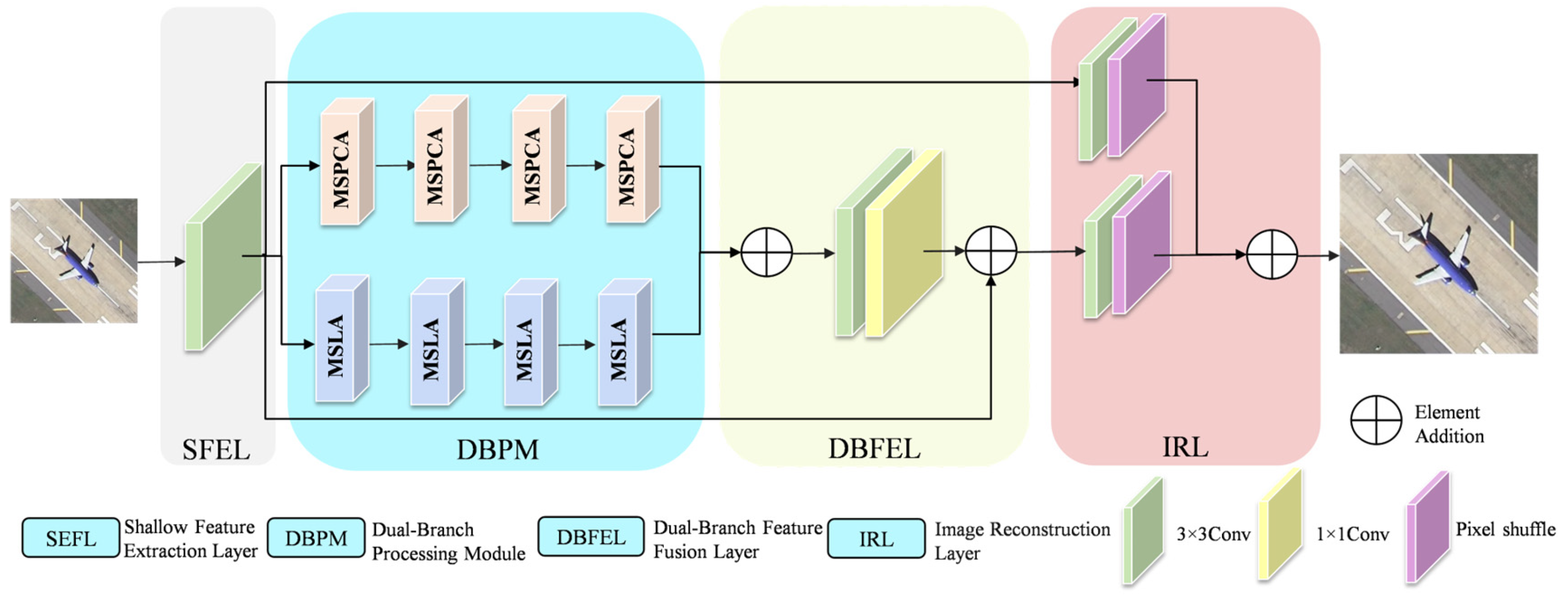

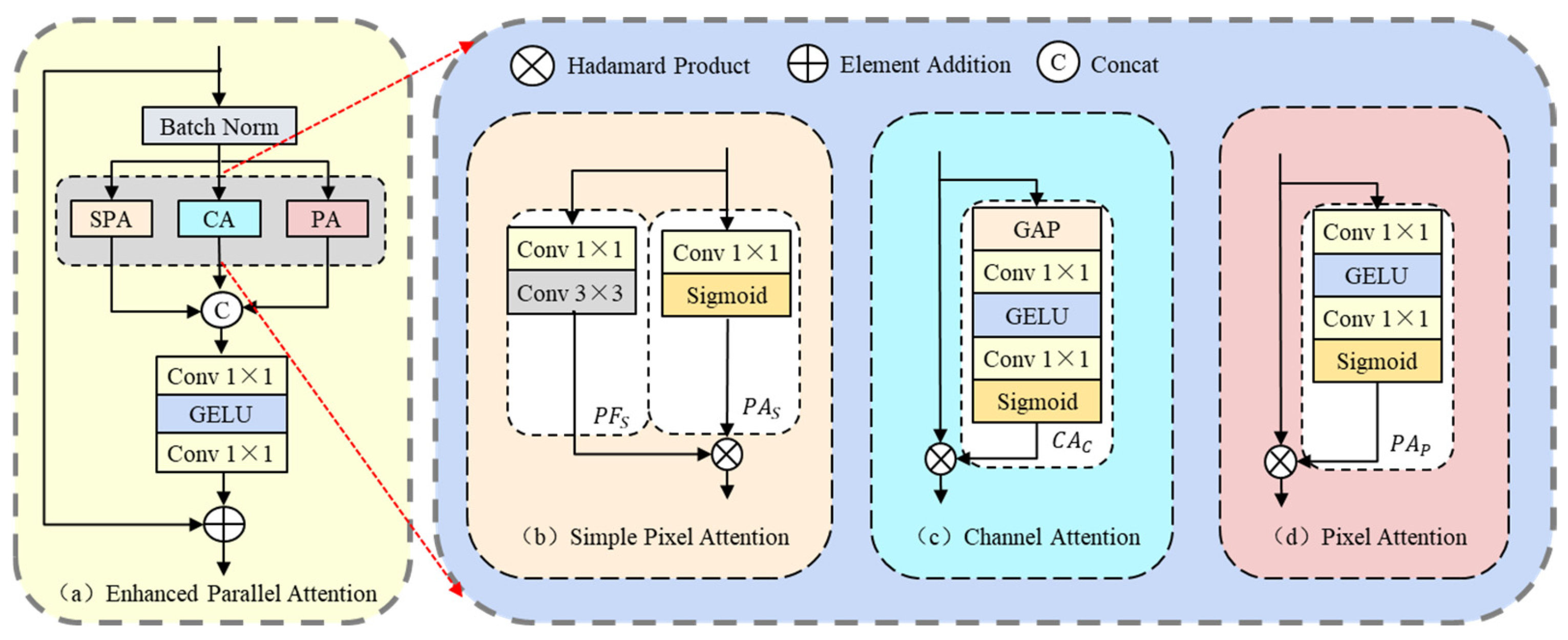
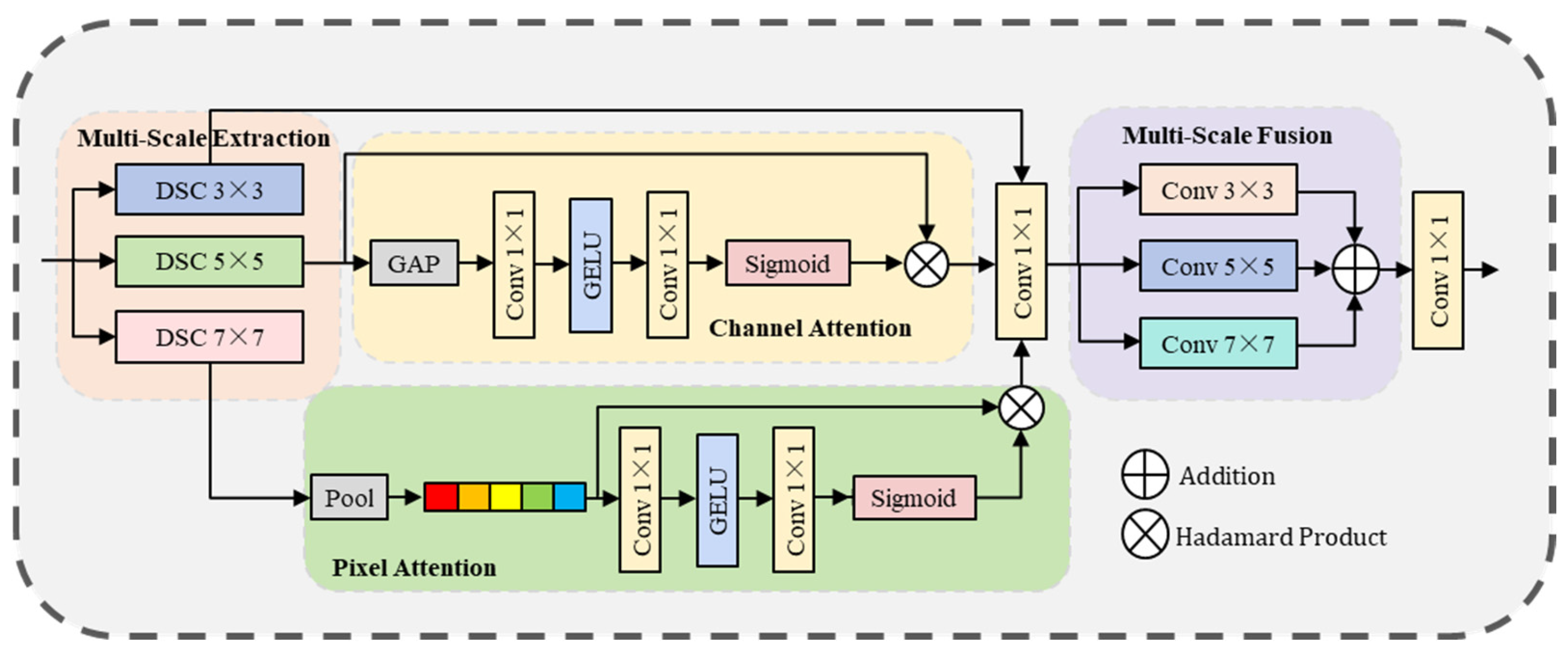

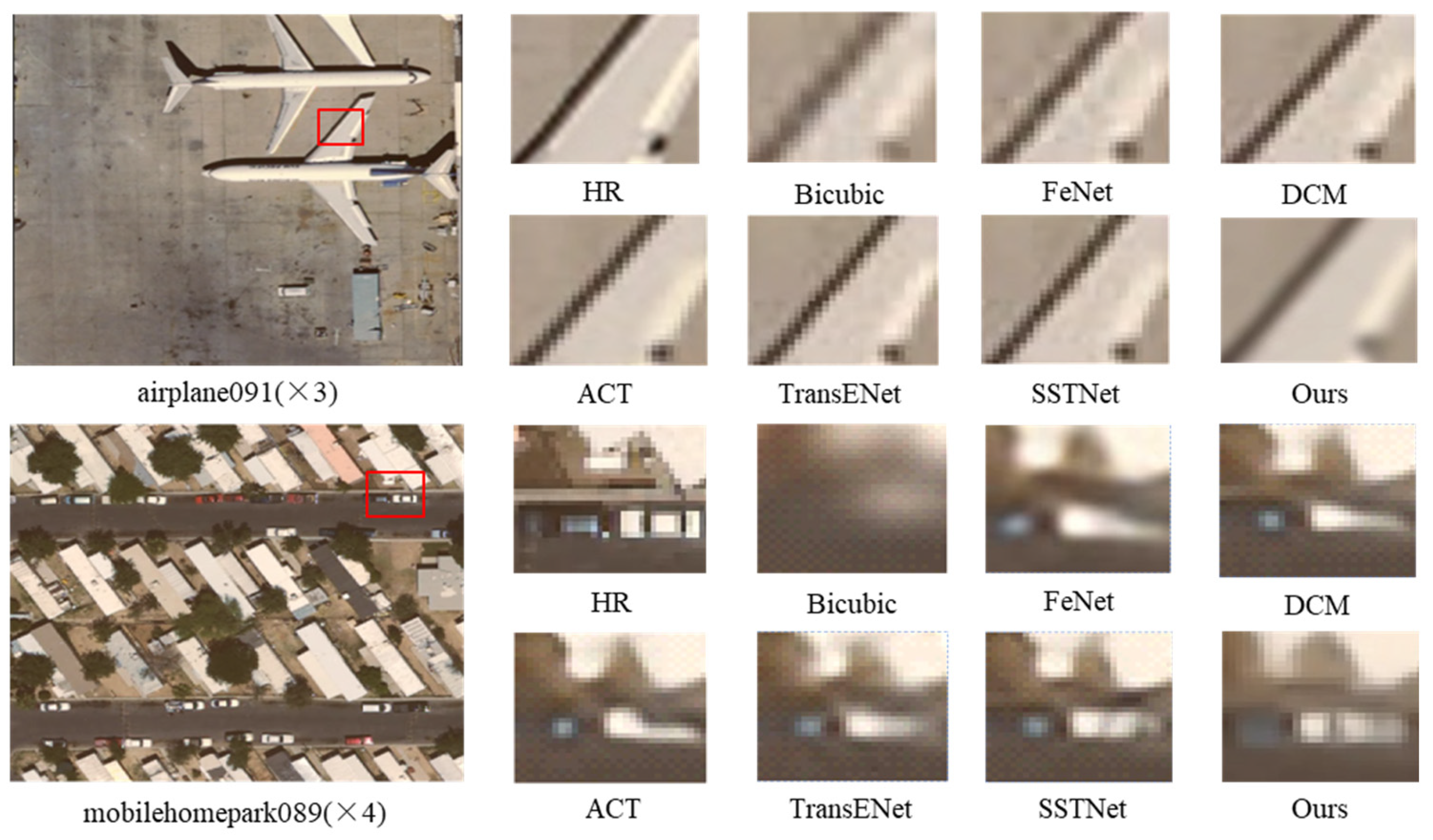
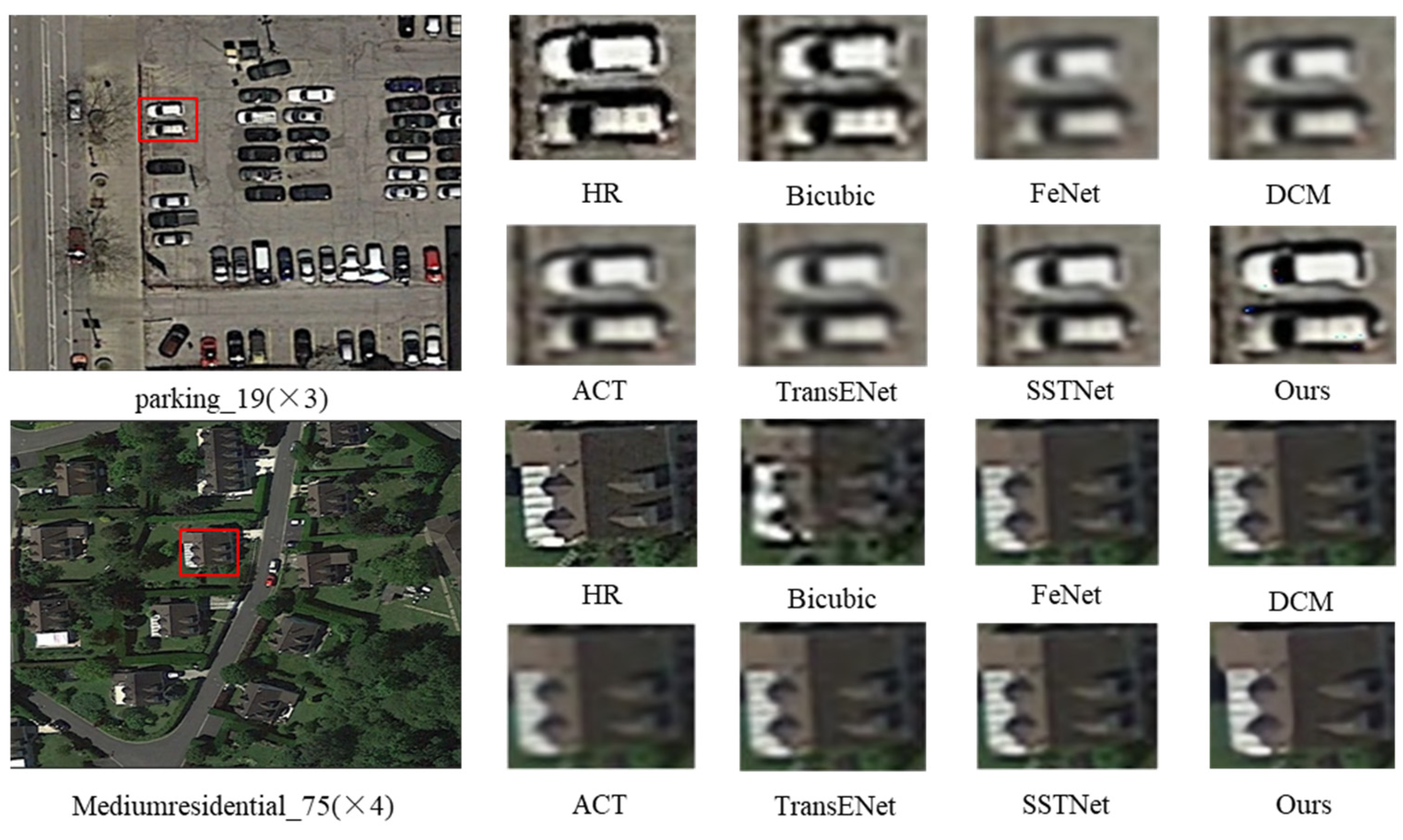
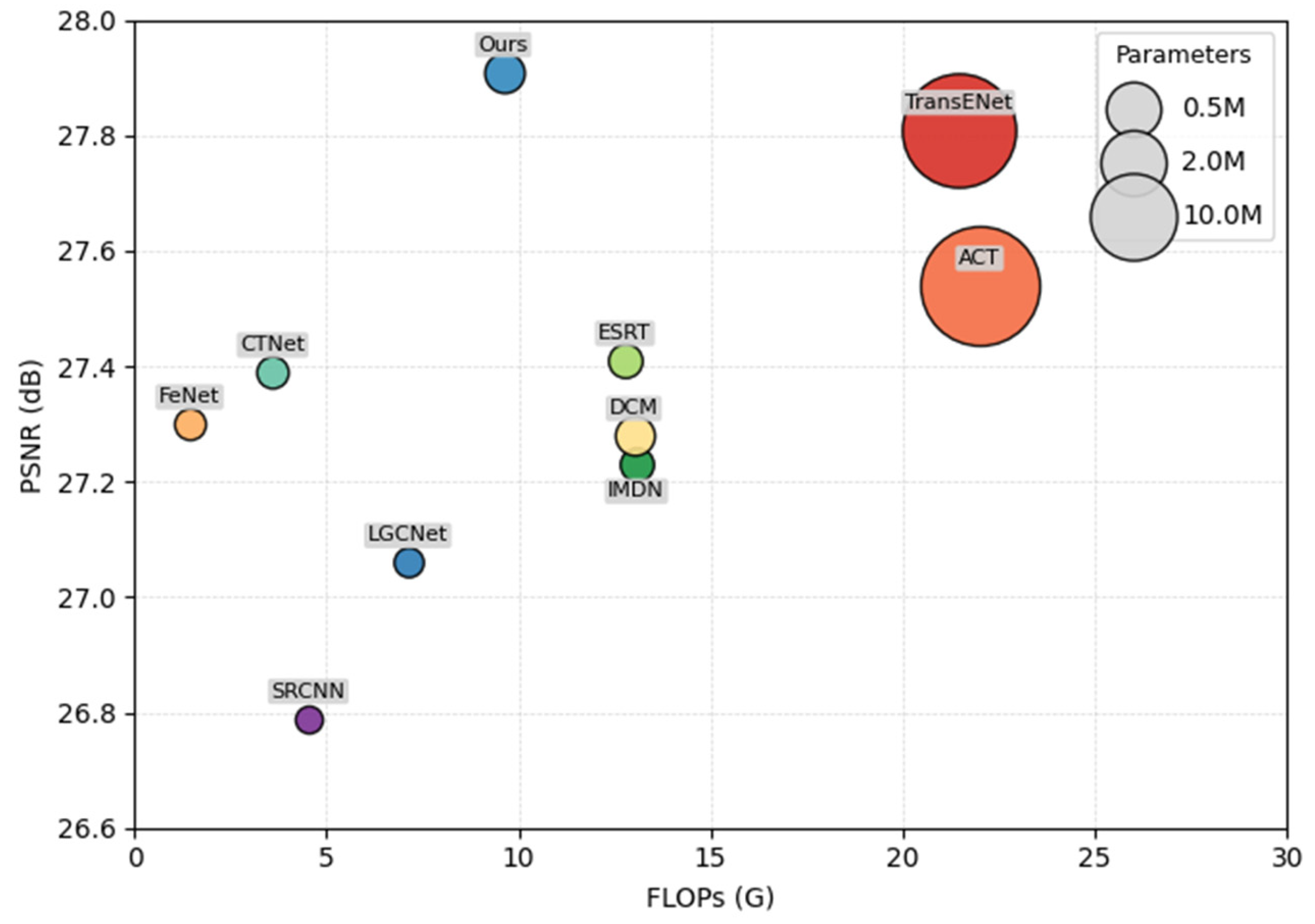
| Method | Scale | Params | UC Merced | AID | ||
|---|---|---|---|---|---|---|
| PSNR/dB | SSIM | PSNR/dB | SSIM | |||
| Bicubic | ×2 | -/- | 30.76 | 0.8789 | 32.39 | 0.8906 |
| SRCNN [12] | 57 K | 32.86 | 0.9077 | 34.49 | 0.9286 | |
| LGCNet [30] | 193 K | 33.73 | 0.9231 | 35.05 | 0.9312 | |
| IMDN [22] | 694 K | 33.52 | 0.9243 | 35.10 | 0.9346 | |
| CTNet [24] | 413 K | 33.61 | 0.9264 | 35.13 | 0.9354 | |
| ESRT [23] | 750 K | 33.70 | 0.9270 | 35.15 | 0.9358 | |
| DCM [31] | 2.18 M | 33.68 | 0.9277 | 35.21 | 0.9366 | |
| FeNet [32] | 351 K | 33.62 | 0.9264 | 35.15 | 0.9361 | |
| ACT [36] | 46.1 M | 33.88 | 0.9283 | 35.17 | 0.9362 | |
| TransEnet [37] | 37.3 M | 34.06 | 0.9294 | 35.28 | 0.9374 | |
| SSTNet [40] | 34.14 M | 34.09 | 0.9311 | 35.29 | 0.9376 | |
| Ours | 1.87 M | 34.10 | 0.9313 | 35.33 | 0.9376 | |
| Bicubic | ×3 | -/- | 27.46 | 0.7631 | 29.08 | 0.7863 |
| SRCNN [12] | 57 K | 28.92 | 0.8116 | 30.60 | 0.8380 | |
| LGCNet [30] | 193 K | 29.29 | 0.8241 | 30.73 | 0.8417 | |
| IMDN [22] | 694 K | 29.42 | 0.8315 | 31.14 | 0.8518 | |
| CTNet [24] | 413 K | 29.41 | 0.8322 | 31.16 | 0.8527 | |
| ESRT [23] | 750 K | 29.52 | 0.8318 | 31.23 | 0.8527 | |
| DCM [31] | 2.18 M | 29.52 | 0.8391 | 31.31 | 0.8561 | |
| FeNet [32] | 351 K | 29.47 | 0.8320 | 31.25 | 0.8538 | |
| ACT [36] | 46.1 M | 29.80 | 0.8395 | 31.39 | 0.8576 | |
| TransEnet [37] | 37.3 M | 29.92 | 0.8406 | 31.45 | 0.8585 | |
| SSTNet [40] | 34.14 M | 29.88 | 0.8397 | 31.45 | 0.8595 | |
| Ours | 2.08 M | 29.97 | 0.8404 | 31.56 | 0.8577 | |
| Bicubic | ×4 | -/- | 25.65 | 0.6725 | 27.30 | 0.7036 |
| SRCNN [12] | 57 K | 26.79 | 0.7243 | 28.45 | 0.7560 | |
| LGCNet [30] | 193 K | 27.06 | 0.7339 | 28.61 | 0.7632 | |
| IMDN [22] | 694 K | 27.23 | 0.7432 | 28.96 | 0.7698 | |
| CTNet [24] | 413 K | 27.39 | 0.7513 | 29.00 | 0.7768 | |
| ESRT [23] | 750 K | 27.41 | 0.7485 | 29.18 | 0.7831 | |
| DCM [31] | 2.18 M | 27.28 | 0.7533 | 29.17 | 0.7824 | |
| FeNet [32] | 351 K | 27.30 | 0.7447 | 29.08 | 0.7804 | |
| ACT [36] | 46.1 M | 27.54 | 0.7531 | 29.19 | 0.7836 | |
| TransEnet [37] | 37.3 M | 27.81 | 0.7639 | 29.38 | 0.7909 | |
| SSTNet [40] | 34.14 M | 27.66 | 0.7598 | 29.34 | 0.7896 | |
| Ours | 2.37 M | 27.91 | 0.7696 | 29.52 | 0.7928 | |
| Class | SRCNN | LGCNet | IMDN | CTNet | ESRT | FeNet | DCM | ACT | TransEnet | SSTNet | Ours |
|---|---|---|---|---|---|---|---|---|---|---|---|
| Agricultural | 27.44 | 27.64 | 28.49 | 28.53 | 28.13 | 28.45 | 29.06 | 27.87 | 28.02 | 28.02 | 28.50 |
| Airplane | 28.65 | 29.23 | 29.23 | 29.22 | 29.45 | 29.35 | 30.66 | 29.78 | 29.94 | 29.94 | 30.67 |
| Baseballdiamond | 34.56 | 34.75 | 34.95 | 34.81 | 34.88 | 34.81 | 33.87 | 35.03 | 35.04 | 35.04 | 35.04 |
| Beach | 37.11 | 37.28 | 37.46 | 37.38 | 37.45 | 37.46 | 36.38 | 37.56 | 37.53 | 37.59 | 37.27 |
| Buildings | 27.22 | 27.88 | 27.97 | 27.99 | 28.18 | 28.10 | 28.51 | 28.66 | 28.81 | 28.74 | 29.15 |
| Chaparral | 26.18 | 26.35 | 26.42 | 26.40 | 26.43 | 26.39 | 26.81 | 26.62 | 26.69 | 26.69 | 26.88 |
| Denseresidential | 27.77 | 28.29 | 28.43 | 28.42 | 28.53 | 28.42 | 28.79 | 28.97 | 29.11 | 29.12 | 28.45 |
| Forest | 28.35 | 28.41 | 28.42 | 28.48 | 28.47 | 28.47 | 28.16 | 28.56 | 28.55 | 28.57 | 29.05 |
| Freeway | 28.89 | 29.55 | 29.54 | 29.60 | 29.87 | 29.75 | 30.45 | 30.25 | 30.38 | 30.47 | 30.57 |
| Golfcourse | 36.33 | 36.46 | 36.47 | 36.46 | 36.54 | 36.49 | 34.43 | 36.63 | 36.68 | 36.65 | 36.44 |
| Harbor | 23.09 | 23.61 | 23.84 | 23.83 | 23.87 | 23.77 | 25.55 | 24.42 | 24.72 | 24.56 | 25.66 |
| Intersection | 27.91 | 28.32 | 28.40 | 28.38 | 28.53 | 28.47 | 29.28 | 28.85 | 29.03 | 29.02 | 29.15 |
| Mediumresidential | 27.35 | 27.78 | 27.83 | 27.87 | 27.93 | 27.89 | 27.77 | 28.30 | 28.47 | 28.42 | 27.85 |
| Mobilehomepark | 24.23 | 24.70 | 24.90 | 24.87 | 24.92 | 24.88 | 24.94 | 25.32 | 25.64 | 25.52 | 25.84 |
| Overpass | 26.14 | 26.84 | 26.87 | 26.89 | 27.17 | 27.03 | 26.89 | 27.76 | 27.83 | 27.87 | 28.19 |
| Parkinglot | 23.20 | 23.46 | 23.50 | 23.59 | 23.72 | 23.69 | 24.44 | 24.11 | 24.45 | 24.38 | 24.54 |
| River | 29.03 | 29.13 | 29.10 | 29.11 | 29.14 | 29.11 | 28.89 | 29.28 | 29.25 | 29.21 | 29.41 |
| Runway | 29.99 | 30.58 | 30.68 | 30.60 | 30.98 | 30.79 | 32.53 | 31.21 | 31.25 | 31.19 | 31.28 |
| Sparseresidential | 30.88 | 31.17 | 31.28 | 31.25 | 31.35 | 31.29 | 30.81 | 31.55 | 31.57 | 31.61 | 31.06 |
| Storagetanks | 31.67 | 32.16 | 32.29 | 32.29 | 32.42 | 32.37 | 29.62 | 32.74 | 32.71 | 32.77 | 32.63 |
| Tenniscourt | 31.28 | 31.59 | 31.68 | 31.74 | 31.99 | 31.93 | 30.76 | 32.40 | 32.51 | 32.54 | 31.64 |
| Average | 28.92 | 29.29 | 29.42 | 29.41 | 29.52 | 29.47 | 29.52 | 29.80 | 29.92 | 29.88 | 29.97 |
| Method | Scale | Param/M | FLOPs/G | PSNR/dB |
|---|---|---|---|---|
| SRCNN [12] | ×4 | 0.057 | 4.53 | 26.79 |
| LGCNet [30] | 0.193 | 7.12 | 27.06 | |
| IMDN [22] | 0.694 | 13.07 | 27.23 | |
| CTNet [24] | 0.413 | 3.6 | 27.39 | |
| ESRT [23] | 0.750 | 12.77 | 27.41 | |
| DCM [31] | 2.18 | 13.0 | 27.28 | |
| FeNet [32] | 0.351 | 1.44 | 27.30 | |
| ACT [36] | 46.1 | 22 | 27.54 | |
| TransEnet [37] | 37.3 | 21.44 | 27.81 | |
| Ours | 2.37 | 9.60 | 27.91 |
| Model | MSPLCK | EPA | MSLA | PSNR/dB | SSIM | FLOPs | Param |
|---|---|---|---|---|---|---|---|
| Baseline | 27.44 | 0.7488 | 3.96 G | 0.97 M | |||
| M0 | ✓ | ✓ | 27.74 | 0.7626 | 6.60 G | 1.63 M | |
| M1 | ✓ | ✓ | 27.70 | 0.7611 | 8.42 G | 2.03 M | |
| M2 | ✓ | ✓ | 27.78 | 0.7633 | 9.20 G | 2.26 M | |
| M3 | ✓ | 27.65 | 0.7585 | 9.66 G | 2.33 M | ||
| M4 | ✓ | 27.70 | 0.7618 | 6.84 G | 1.72 M | ||
| M5 | ✓ | 27.58 | 0.7578 | 4.42 G | 1.08 M | ||
| HSFAN | ✓ | ✓ | ✓ | 27.91 | 0.7696 | 9.60 G | 2.37 M |
| Model | GC3 × 3 | GC5 × 5 | GC7 × 7 | PSNR/dB | SSIM | FLOPs | Param |
|---|---|---|---|---|---|---|---|
| M6 | ✓ | 27.72 | 0.7625 | 9.48 G | 2.34 M | ||
| M7 | ✓ | 27.76 | 0.7627 | 9.58 G | 2.37 M | ||
| M8 | ✓ | 27.82 | 0.7661 | 9.73 G | 2.40 M | ||
| HSFAN | ✓ | ✓ | ✓ | 27.91 | 0.7696 | 9.60 G | 2.37 M |
| Method | CA | PA | SPA | PSNR/dB | SSIM | FLOPs | Param |
|---|---|---|---|---|---|---|---|
| Series | ✓ | ✓ | 27.76 | 0.7640 | 8.44 G | 2.07 M | |
| Series | ✓ | ✓ | ✓ | 27.75 | 0.7632 | 8.56 G | 2.10 M |
| Parallel | ✓ | ✓ | ✓ | 27.91 | 0.7696 | 9.60 G | 2.37 M |
| Model | Conv | Attention | Multi-scale | PSNR/dB | SSIM | FLOPs | Param |
|---|---|---|---|---|---|---|---|
| M9 | ✓ | 27.81 | 0.7662 | 9.90 G | 2.44 M | ||
| M10 | ✓ | 27.85 | 0.7662 | 9.40 G | 2.32 M | ||
| M11 | ✓ | 27.79 | 0.7647 | 9.60 G | 2.36 M | ||
| M12 | ✓ | ✓ | 27.91 | 0.7696 | 9.60 G | 2.37 M |
Disclaimer/Publisher’s Note: The statements, opinions and data contained in all publications are solely those of the individual author(s) and contributor(s) and not of MDPI and/or the editor(s). MDPI and/or the editor(s) disclaim responsibility for any injury to people or property resulting from any ideas, methods, instructions or products referred to in the content. |
© 2025 by the authors. Licensee MDPI, Basel, Switzerland. This article is an open access article distributed under the terms and conditions of the Creative Commons Attribution (CC BY) license (https://creativecommons.org/licenses/by/4.0/).
Share and Cite
Yang, J.; Ren, H.; Zeng, M.; He, Z. HSFAN: A Dual-Branch Hybrid-Scale Feature Aggregation Network for Remote Sensing Image Super-Resolution. Entropy 2025, 27, 1189. https://doi.org/10.3390/e27121189
Yang J, Ren H, Zeng M, He Z. HSFAN: A Dual-Branch Hybrid-Scale Feature Aggregation Network for Remote Sensing Image Super-Resolution. Entropy. 2025; 27(12):1189. https://doi.org/10.3390/e27121189
Chicago/Turabian StyleYang, Jiawei, Hongliang Ren, Mengjie Zeng, and Zhichao He. 2025. "HSFAN: A Dual-Branch Hybrid-Scale Feature Aggregation Network for Remote Sensing Image Super-Resolution" Entropy 27, no. 12: 1189. https://doi.org/10.3390/e27121189
APA StyleYang, J., Ren, H., Zeng, M., & He, Z. (2025). HSFAN: A Dual-Branch Hybrid-Scale Feature Aggregation Network for Remote Sensing Image Super-Resolution. Entropy, 27(12), 1189. https://doi.org/10.3390/e27121189





